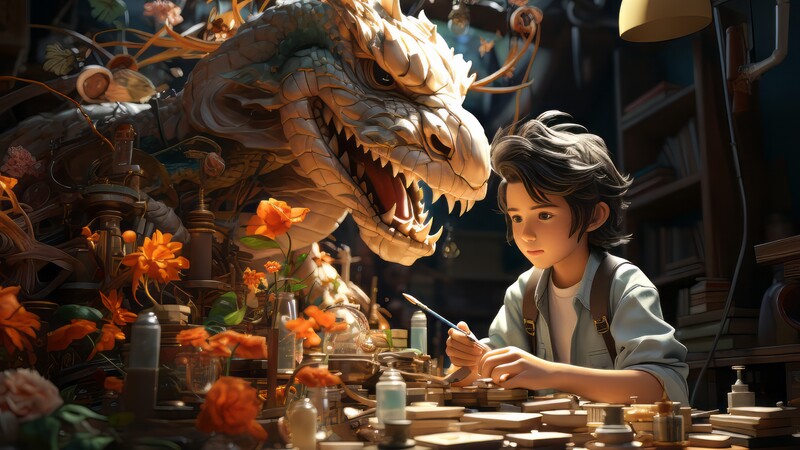Fantasy art offers artists the chance to explore worlds that are beyond the limits of reality. Dragons are one of the most fascinating subjects in fantasy art. They’re powerful, majestic, and shrouded with mystery. This unique design of the 5z_boyjkm98 is a new take on a mythical creature that combines traditional elements with modern twists. Learning to draw the 5z_boyjkm98 can be an exciting journey into fantasy art, whether you are a professional artist or just getting started. This guide will take you step-by-step through the process and offer tips and techniques that can help you bring to life this amazing beast.
Dragon Design 5z_boyjkm98: Understanding the 5z_boyjkm98 Dragon
5z_boyjkm98 is a unique design that incorporates classic dragon features and modern, imaginative twists. The 5z_boyjkm98 dragon’s unique anatomy features scales, wings and a muscular body that exudes power and grace. It’s important to know the key elements that make the dragon unique before you begin drawing. Concentrate on its key features, such as its elongated nose, its sharp talons and the intricate pattern in its scales.
Gathering Materials
You’ll need to have the right tools in order to begin drawing your 5z_boyjkm98 Dragon. Begin with the basics, such as pencils, erasers and drawing papers of high quality. Consider using fine liners and inking pens for a more polished, detailed finish. Graphic tablets and design programs like Adobe Photoshop or Procreate can be beneficial to digital artists. Use reference images to help you with your artwork and anatomical details.
Sketching the Basic Structure
A solid foundation is the basis of every great drawing. Start by drawing the basic structure of your Dragon. Use simple shapes such as circles for the body and head, and lines for the limbs. This step is essential for establishing the overall pose and proportions of the dragon. At this stage, don’t focus on details; instead, concentrate on the overall form and placement of the dragon.
Refine the head and facial features
Start by refining the shape of the skull and jawline. Begin by redefining the jawline and skull shape. Detail the dragon’s eyes, nostrils and powerful jaw muscles. Pay attention to the smooth and rough textures of the 5z_boyjkm98’s face as you draw. Add unique features to your dragon, such as horns or spikes.
Draw the Muscles and Body
Then, concentrate on the body of the dragon. Start by defining the neck and chest. Make sure to accurately represent the muscles and bone structure. Dragons are usually depicted with muscular bodies, so make sure to emphasize the contours along the chest and abdomen. This will give the dragon a real sense of strength.
Add the Wings
The wings of a dragon are one of its most distinguishing features. The 5z_boyjkm98 has large, batlike wings with an intricate membrane structure. Sketch the wing bones in a similar way to how a bat would look. Draw the membrane between the bones. Draw the membrane of the wing. This will give the drawing a dynamic feel.
Detailing the Tail
It is important to add balance and movement to your drawing by adding the tail. Begin by sketching out the shape of the tail. It should taper towards the end. To enhance the design of the tail, add scales, fins or spikes. The tail should flow from the body in a natural way, curving and twisted to complement the overall pose of a dragon.
Create the scales and texture
The addition of scales is one of the most difficult but also rewarding aspects of drawing a Dragon. Work your way from the head down the body paying attention to size and direction. The back, limbs and neck may have larger scales while the smaller ones can be found on the underbelly. Shade the scales to create depth and give them a three-dimensional look.
The Outline is Inked
After you are satisfied with the pencil sketch, ink over the lines. Trace over your lines with a fine-liner or an inking pen. Inking makes shapes more solid and highlights details. Variate the thickness of the lines to emphasize certain areas such as the jawline and wing edges.
Shades and Highlights
The shading is what gives your dragon life. It adds depth and dimension. Add shadows along the scales, the underside of the wings and the muscles using a variety of pencils. You can add highlights with a white pen or digitally using a soft brush. Be sure to pay attention to the light source, and that all shadows and highlights remain consistent.
Adding Background Elements
Consider adding a background to your dragon drawing. You can use a simple scene, such as a mountain range or forest, or something more complex, like a dragon’s lair. The background should compliment the dragon, without overwhelming it. Keep the focus on your dragon by using lighter shades and less details.
The final touches and polishing
Add any final details to your drawing and polish it. You can add textures, refine the shadows or even add a little color to the eyes and background. View your work from afar to make sure that it is balanced, and that there are no missing details.
conclusion
The 5z_boyjkm98 Dragon is a creative and exciting challenge that will allow you to explore the world of fantasy. This guide will help you bring the mythical creature alive on paper. Practice and patience are the keys to mastering dragon artwork. You’ll soon be able to create your own dragon designs that will captivate and inspire. The 5z_boyjkm98 is a great project for anyone who wants to draw something fun, or build up a portfolio. It combines imagination and precision.




